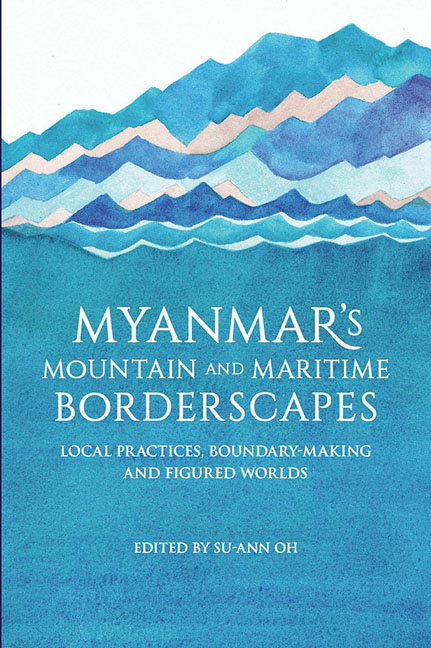Book contents
- Frontmatter
- Contents
- List of Tables
- List of Figures
- Acknowledgements
- Notes on Language, Terminology and Geographical Names
- Contributors
- Abbreviations
- 1 Introduction
- I Overview of Myanmar's Mountain and Maritime Borderscapes
- II Territorial Claims and Imagined Boundaries
- III Social Organization and Border Economies
- IV Mobile Practices and Moving Borders
- V Identity Construction and the Politics of Belonging
- 11 “I Want to Stay Forever in You”
- 12 Life along the Naf Border: Identity Politics of the Rohingya Refugees in Bangladesh
- 13 Home of the Housekeeper: Will Shan Migrants Return after a Decade of Migration?
- 14 Moving on: Spaces of Engagement in the Kayah–Mae Hong Son Borderland
- VI Institutionalized Identity and Border Practices
- Index
11 - “I Want to Stay Forever in You”
from V - Identity Construction and the Politics of Belonging
Published online by Cambridge University Press: 06 June 2017
- Frontmatter
- Contents
- List of Tables
- List of Figures
- Acknowledgements
- Notes on Language, Terminology and Geographical Names
- Contributors
- Abbreviations
- 1 Introduction
- I Overview of Myanmar's Mountain and Maritime Borderscapes
- II Territorial Claims and Imagined Boundaries
- III Social Organization and Border Economies
- IV Mobile Practices and Moving Borders
- V Identity Construction and the Politics of Belonging
- 11 “I Want to Stay Forever in You”
- 12 Life along the Naf Border: Identity Politics of the Rohingya Refugees in Bangladesh
- 13 Home of the Housekeeper: Will Shan Migrants Return after a Decade of Migration?
- 14 Moving on: Spaces of Engagement in the Kayah–Mae Hong Son Borderland
- VI Institutionalized Identity and Border Practices
- Index
Summary
WAR, MOTHER AND YOUTH
From independence in 1948 to the 2010 historic general election, the voices of peoples in Burma/Myanmar were by and large imperceptible. During those sixty-two years, Burma/Myanmar did not figure much in world politics, compared to the chronicity of political crises therein. The first fourteen years saw it engaged in a chaotic form of democracy that ended when it became a hermit state after General Ne Win's coup d’état in 1962. Before the 2010 election, the world community turned its eyes to Burma/Myanmar only when there were mass killings: the 8/8/88 massacre and the Saffron Revolution from 18 to 26 September 2007. In other words, the international community did not by and large regard crises in Burma/ Myanmar as international problems — until crisis struck the country again. In this light, the 2010 election was the dawn of metamorphosis both inside and along the country's border zones. However, the international community has been too optimistic about this metamorphosis.
Until May 2014, I had been reflecting upon Burma/Myanmar's future through its past. Even though the country's future looks promising, it is hard to ignore the reality that many people are still suffering: Muslims, the Kachin, and hundreds of thousands of people living in what the Thai state calls “temporary shelter areas” along the Thai-Burmese border. This article is written to record the voices of some of the people living along the border — especially those of the young — without which they will be forgotten. In this introduction, I present a montage of events occurring from 2009 to 2010, before this seemingly promising period of political change.
CHILDREN AND A MOTHER'S MEMORY
Fighting broke out along the Thai-Burmese border zones one day after the historic election on 7 November 2010. For many of those attempting to flee to Thailand, weakened health caused by the displacement led to an early death. For others, it came upon them abruptly without much time for those left behind to prepare themselves emotionally.
Such fragility of life happened to a group of villagers attempting to flee to Thailand.
- Type
- Chapter
- Information
- Myanmar's Mountain and Maritime BorderscapesLocal Practices, Boundary-Making and Figured Worlds, pp. 261 - 282Publisher: ISEAS–Yusof Ishak InstitutePrint publication year: 2016

